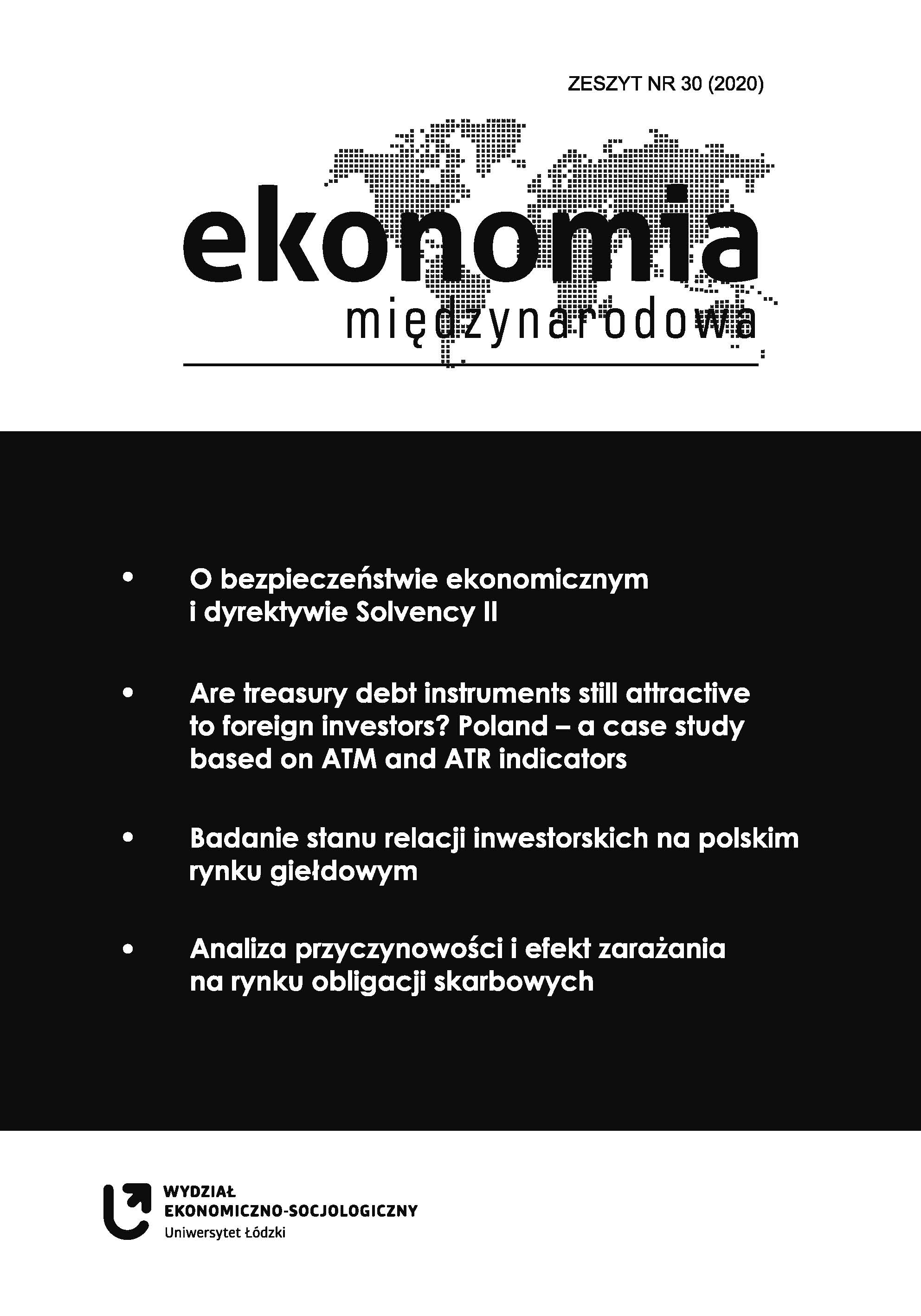Czy skarbowe instrumenty dłużne są nadal atrakcyjne dla inwestorów zagranicznych? Polska – studium przypadku z wykorzystaniem wskaźników ATM i ATR
DOI:
https://doi.org/10.18778/2082-4440.30.02Słowa kluczowe:
dług publiczny, inwestorzy zagraniczni, polskie skarbowe papiery wartościowe, zarządzanie długiem publicznymAbstrakt
Głównym celem artykułu jest ocena aktywności inwestorów zagranicznych na polskim, pierwotnym rynku instrumentów dłużnych w świetle strategii zarządzania długiem publicznym. Sprawdzono skalę reakcji inwestorów na politykę władz w obszarze długu państwowego. Artykuł składa się z pięciu części: wprowadzenia, przeglądu literatury, opisu metody badawczej i danych, oraz dyskusji wyników. Najważniejsze ustalenia, uwagi końcowe i implikacje polityczne zostały przedstawione w ostatniej części opracowania. Wyniki badania wskazały, że pomimo pogorszenia się ogólnej charakterystyki instrumentów dłużnych Skarbu Państwa skierowanych do inwestorów zagranicznych, pozostały one atrakcyjne dla nierezydentów. Wynikało to głównie z wciąż stosunkowo niskiego ryzyka refinansowania i stopy procentowej dla długu denominowanego w walutach obcych.
Bibliografia
Ahlquist, J.S. (2006). Economic Policy, Institutions, and Capital Flows: Portfolio and Direct Investment Flows in Developing Countries, “International Studies Quarterly”, 50(3): 681–704.
Google Scholar
DOI: https://doi.org/10.1111/j.1468-2478.2006.00420.x
Arslanalp, S., Tsuda, T. (2014). Tracking Global Demand for Advanced Economy Sovereign Debt, “IMF Economic Review”, 62(3): 430–464.
Google Scholar
DOI: https://doi.org/10.1057/imfer.2014.20
Barro, R.J. (1989). The Ricardian approach to budget deficits, “Journal of Economic Perspectives”, 3(2): 37–54.
Google Scholar
DOI: https://doi.org/10.1257/jep.3.2.37
Bitzenis, A., Žugić, V. (2014). FDI Motives in the Serbian Manufacturing Sector, “Journal of East-West Business”, 20(1): 1–24.
Google Scholar
DOI: https://doi.org/10.1080/10669868.2013.851637
Capasso, S., Neanidis, K. (2019). Domestic or foreign currency? Remittances and the composition of deposits and loans, “Journal of Economic Behavior & Organization”, 160: 168–183.
Google Scholar
DOI: https://doi.org/10.1016/j.jebo.2019.01.023
Cazac, D. (2018). Operational Risk Administration – Essential Component of Public Debt Management Efficiency, “Knowledge Horizons”, 10(4): 45–55.
Google Scholar
Fan, J., Arghyrou, M.G. (2013). UK Fiscal Policy Sustainability, 1955–2006, “The Manchester School”, 81(6): 961–991.
Google Scholar
DOI: https://doi.org/10.1111/j.1467-9957.2012.02319.x
Garg, R., Dua, P. (2014). Foreign Portfolio Investment Flows to India: Determinants and Analysis, “World Development”, 59: 16–28.
Google Scholar
DOI: https://doi.org/10.1016/j.worlddev.2014.01.030
Grover, R., Walacik, M. (2019). Property Valuation and Taxation for Fiscal Sustainability – Lessons for Poland, “Real Estate Management & Valuation”, 27(1): 35–48.
Google Scholar
DOI: https://doi.org/10.2478/remav-2019-0004
Grundke, P. (2004). Integrating Interest Rate Risk in Credit Portfolio Models, “Journal of Risk Finance”, 5(2): 6–15.
Google Scholar
DOI: https://doi.org/10.1108/eb022982
Hayat, A. (2019). Foreign Direct Investments, Institutional Quality, and Economic Growth, “Journal of International Trade & Economic Development”, 28(5): 561–579.
Google Scholar
DOI: https://doi.org/10.1080/09638199.2018.1564064
Ho, H.K., Atkinson, R. (2018). Looking for big ‘fry’: The Motives and Methods of Middle-Class International Property Investors, “Urban Studies”, 55(9): 2040–2056.
Google Scholar
DOI: https://doi.org/10.1177/0042098017702826
Kremers, J.J.M. (1989). US Federal Indebtedness and the Conduct of Fiscal Policy, “Journal of Monetary Economics”, 23(2): 219–238.
Google Scholar
DOI: https://doi.org/10.1016/0304-3932(89)90049-4
Mackiewicz-Łyziak, J. (2015). Fiscal Sustainability in CEE Countries - the Case of the Czech Republic, Hungary and Poland, “Equilibrium”, 10(2): 53–71.
Google Scholar
DOI: https://doi.org/10.12775/EQUIL.2015.013
Martins-da-Rocha, V-.F., Vailakis, Y. (2012). On Ponzi schemes in infinite horizon collateralized economies with default penalties, “Annals of Finance”, 8(4): 455–488.
Google Scholar
DOI: https://doi.org/10.1007/s10436-012-0209-y
Matsumura, K., Kakinoki, H. (2014). Portfolio Strategy Optimizing Model for Risk Management Utilizing Evolutionary Computation, “Electronics & Communications in Japan”, 97(8): 45–62.
Google Scholar
DOI: https://doi.org/10.1002/ecj.11587
McCallum, B.T. (1984). Are Bond-financed Deficits Inflationary?: A Ricardian Analysis, “Journal of Political Economy”, 92(1): 123–134.
Google Scholar
DOI: https://doi.org/10.1086/261211
Minea, A., Villieu, P. (2010). Endogenous growth, government debt and budgetary regimes: a corrigendum, “Journal of Macroeconomics”, 32(2): 709–711.
Google Scholar
DOI: https://doi.org/10.1016/j.jmacro.2009.11.003
Neck, R., Sturm, J-.E. (2008). Sustainability of public debt. Cambridge, MA: Massachusetts Institute of Technology Press.
Google Scholar
DOI: https://doi.org/10.7551/mitpress/9780262140980.001.0001
Nougayrède, D. (2018). Towards a Global Financial Register? The Case for End Investor Transparency in Central Securities Depositories, “Journal of Financial Regulation”, 4(2): 276–313.
Google Scholar
DOI: https://doi.org/10.1093/jfr/fjy003
Pascal, M. (2011). Public Debt Management – Fundamental Component of Public Policy, “Centre for European Studies Working Papers”, 3(4): 571–578.
Google Scholar
Steger, G. (2013). Redirecting public finance towards a sustainable path, “OECD Journal on Budgeting”, 2012(2): 61–67.
Google Scholar
DOI: https://doi.org/10.1787/budget-12-5k8zsl7n94s8
Strategia zarządzania długiem sektora finansów publicznych w latach 2019–2022 [Public debt management strategy 2019–2022] (2018), Ministry of Finance, Warsaw. https://www.gov.pl/web/finanse/strategie-zarzadzania-dlugiem (accessed: April 2019).
Google Scholar
Uryszek, T. (2016). Primary Deficit Indicator, Tax Gap, and Fiscal Sustainability – Evidence from Central and Eastern EU Member States, “FINANSE. Czasopismo Komitetu Nauk o Finansach PAN”, 1(9): 103–116.
Google Scholar
Uryszek, T. (2019). Can Fiscal Paths Be Sustainable? Evidence from Poland, “Emerging Markets Finance and Trade”, https://doi.org/10.1080/1540496X.2019.1668768
Google Scholar
DOI: https://doi.org/10.1080/1540496X.2019.1668768
Wigger, B.U. (2009). A note on public debt, tax-exempt bonds, and Ponzi games, “Journal of Macroeconomics”, 31(3): 492–499.
Google Scholar
DOI: https://doi.org/10.1016/j.jmacro.2008.07.003
Pobrania
Opublikowane
Jak cytować
Numer
Dział
Licencja

Utwór dostępny jest na licencji Creative Commons Uznanie autorstwa – Użycie niekomercyjne – Bez utworów zależnych 4.0 Międzynarodowe.









